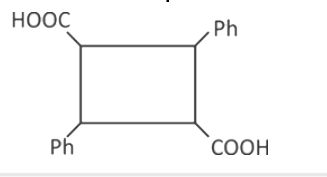The number of optical isomers of the compound CH3CHBrCHBrCOOH is
2
4
3
1
The correct Answer is:4
To determine the number of optical isomers of the compound CH3CHBrCHBrCOOH, we will follow these steps:
Step 1: Identify the Structure
First, we need to draw the structure of the compound CH3CHBrCHBrCOOH. This compound consists of a four-carbon chain with two bromine atoms and a carboxylic acid group.
Step 2: Identify Chiral Centers
Next, we need to identify the chiral centers in the molecule. A chiral center is a carbon atom that is attached to four different groups.
In the structure of CH3CHBrCHBrCOOH:
- The second carbon (attached to CH3, Br, CHBr, and COOH) is a chiral center.
- The third carbon (attached to Br, CH3, COOH, and the adjacent carbon) is also a chiral center.
Step 3: Count the Chiral Centers
We have identified 2 chiral centers in the compound.
Step 4: Calculate the Number of Optical Isomers
The number of optical isomers can be calculated using the formula:
Number of optical isomers=2n
where n is the number of chiral centers.
Substituting n=2:
Number of optical isomers=22=4
Step 5: Identify the Isomers
The four optical isomers consist of two pairs of enantiomers:
1. The first pair of enantiomers (let's call them Isomer 1 and Isomer 2).
2. The second pair of enantiomers (let's call them Isomer 3 and Isomer 4).
Each pair consists of structures that are mirror images of each other and are not superimposable.
Conclusion
Thus, the total number of optical isomers for the compound CH3CHBrCHBrCOOH is 4.
---
First, we need to draw the structure of the compound CH3CHBrCHBrCOOH. This compound consists of a four-carbon chain with two bromine atoms and a carboxylic acid group.
Next, we need to identify the chiral centers in the molecule. A chiral center is a carbon atom that is attached to four different groups.
- The second carbon (attached to CH3, Br, CHBr, and COOH) is a chiral center.
- The third carbon (attached to Br, CH3, COOH, and the adjacent carbon) is also a chiral center.
We have identified 2 chiral centers in the compound.
The number of optical isomers can be calculated using the formula:
Number of optical isomers=2n
where n is the number of chiral centers.
Number of optical isomers=22=4
The four optical isomers consist of two pairs of enantiomers:
1. The first pair of enantiomers (let's call them Isomer 1 and Isomer 2).
2. The second pair of enantiomers (let's call them Isomer 3 and Isomer 4).
Thus, the total number of optical isomers for the compound CH3CHBrCHBrCOOH is 4.
Topper's Solved these Questions
- TEST PAPERSBOOK - RESONANCE ENGLISHCHAPTER - TEST PAPERSEXERCISE - FST test -2
30 Videos
- TEST PAPERSBOOK - RESONANCE ENGLISHCHAPTER - TEST PAPERSEXERCISE - FST-3
30 Videos
- TEST PAPERSBOOK - RESONANCE ENGLISHCHAPTER - TEST PAPERSEXERCISE - PT-06
30 Videos
- SURFACE CHEMISTRYBOOK - RESONANCE ENGLISHCHAPTER - SURFACE CHEMISTRYEXERCISE - Section - 5
1 Videos
- TEST SERIESBOOK - RESONANCE ENGLISHCHAPTER - TEST SERIESEXERCISE - CHEMISTRY
50 Videos
Similar Questions
Knowledge Check
Total number of stereoisomers of the compound
CH3−CH=CH−CH∣OH−CH=CH−CH3 is :A2B3C4D8The number of enantiomers of the compound CH3−CH∣Br−CH∣Br−COOH is
A2B3C4D6
The number of stereoisomers of compound CH3−CH=CH−CH(Br)CH3 is :
View SolutionFind the number of optical isomers for this sizes compound.

View SolutionThe name of the compound CH3−CH2−CHO is
View SolutionThe number of optical isomers of CH3CH(OH)CH(OH)CHO is :-
View SolutionFind the number of geometrical isomers of the given compound .
C6H5−CH=CH−CH−CH=CH−CH=CH−COOH
View SolutionThe number of geometrical isomers in CH3CH=N−OH is
View Solution
